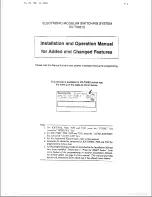
9
Defender
™ Series Bases Service Manual
1.10
How Load Cells Operate
Load Cells convert force into a signal. The Defender Series Bases have a Strain Gauge Load Cell, which is
made from a metal beam with holes drilled in it. Strain gauges are affixed to the beam at the top and bottom to
measure changes in the beam due to deflection. The gauges are bonded very securely to the metal, where
they sense very small deflections in the metal caused by the load being applied to the cell. Because the signal
levels are very small, the circuit is protected from all outside influences such as moisture, physical damage, or
electrical interference.
Figure 1-1. Typical Strain Gauge Load Cell.
The strain gauges are wired into a Wheatstone Bridge Circuit. (See Figure 1-2.)
Figure 1-2. Downward force on the Platform bends the beam, causing two gauges to stretch and
two to compress in opposition, changing the electrical resistance of the circuit.
At zero load, all strain gauges are unstressed. Weight placed on the Platform bends the beam, causing
two gauges to stretch and two to compress in opposition, changing the electrical resistance of the circuit.
The difference in the output signal before and after the mass was placed on the platform is measured,
interpreted and displayed.
Force
Wheatstone Bridge Circuit
Strain Gauge
+
+
Strain Gauge
–
Strain Gauge
Strain Gauge
–
Printed Circuit Board (PCB )
completing Wheatstone
Bridge circuit
Strain Gauges
Internal PCB
Beam
Attachment
points to
Platform











































